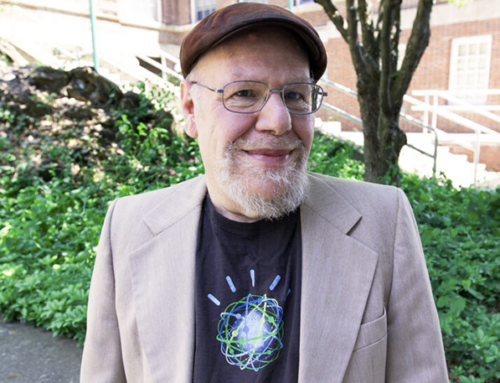By Sariah Marth, doctoral candidate in chemistry
There’s a lot we all know about water. I’m sure if asked, anyone could name an interesting fact about water. What makes the Earth unique? What makes life on Earth possible? Water. It makes up over 70% of the planet and over 60% of your body. In fact, water is so impactful on this planet that recent polar ice cap melt has changed the distribution of water and this has increased the amount of time it takes for the Earth to orbit the Sun. How wild is that?
What if water had another power? What if we could use water to power the world? We all know we need to move to using cleaner energy to replace fossil fuels, and many people believe that hydrogen is the fuel of the future. Instead of burning fossil fuels and releasing carbon dioxide, we can use hydrogen derived from water for power and our waste products will be water and air.
So, how can we make that hydrogen? We can use a little device called an electrolyzer. With this, we take raw material water and pass it through a really thin membrane, called a bipolar membrane. In the bipolar membrane, we break water apart into separate, charged pieces — one positive and one negative. This membrane is unique because like a magnet, it’s also charged. It has an area that’s positively charged and one that’s negatively charged. It works like a magnet to pull those charged pieces apart. Once separated, we can repackage those pieces as hydrogen and oxygen gases.
Oxygen can be used in life support systems and hydrogen is the most important product we get out of this because we can use it for fuel in space exploration, we can use it for the electrification of industry, we can even use it for transportation.
Now, electrolysis isn’t a new process — we’ve been using water to generate hydrogen and oxygen for medical oxygen since the late 1800s — but it’s incredibly inefficient. It takes a lot of energy to produce hydrogen. The manufacturing process for these membranes is environmentally harmful and it’s expensive because we must use metals like platinum.
My research focuses on matching materials and the properties of materials to develop novel bipolar membranes that last longer than currently available membranes, take less energy to drive hydrogen production, and are cheaper through the use of metals like nickel.
Water is a vital resource. Let’s use this resource for the future of clean energy. Why not a water-powered world?
The content of this post, which has been edited for clarity, was originally part of RPI’s Three Minute Thesis Competition, which challenges doctoral students to effectively explain their research to a general audience in three minutes.




